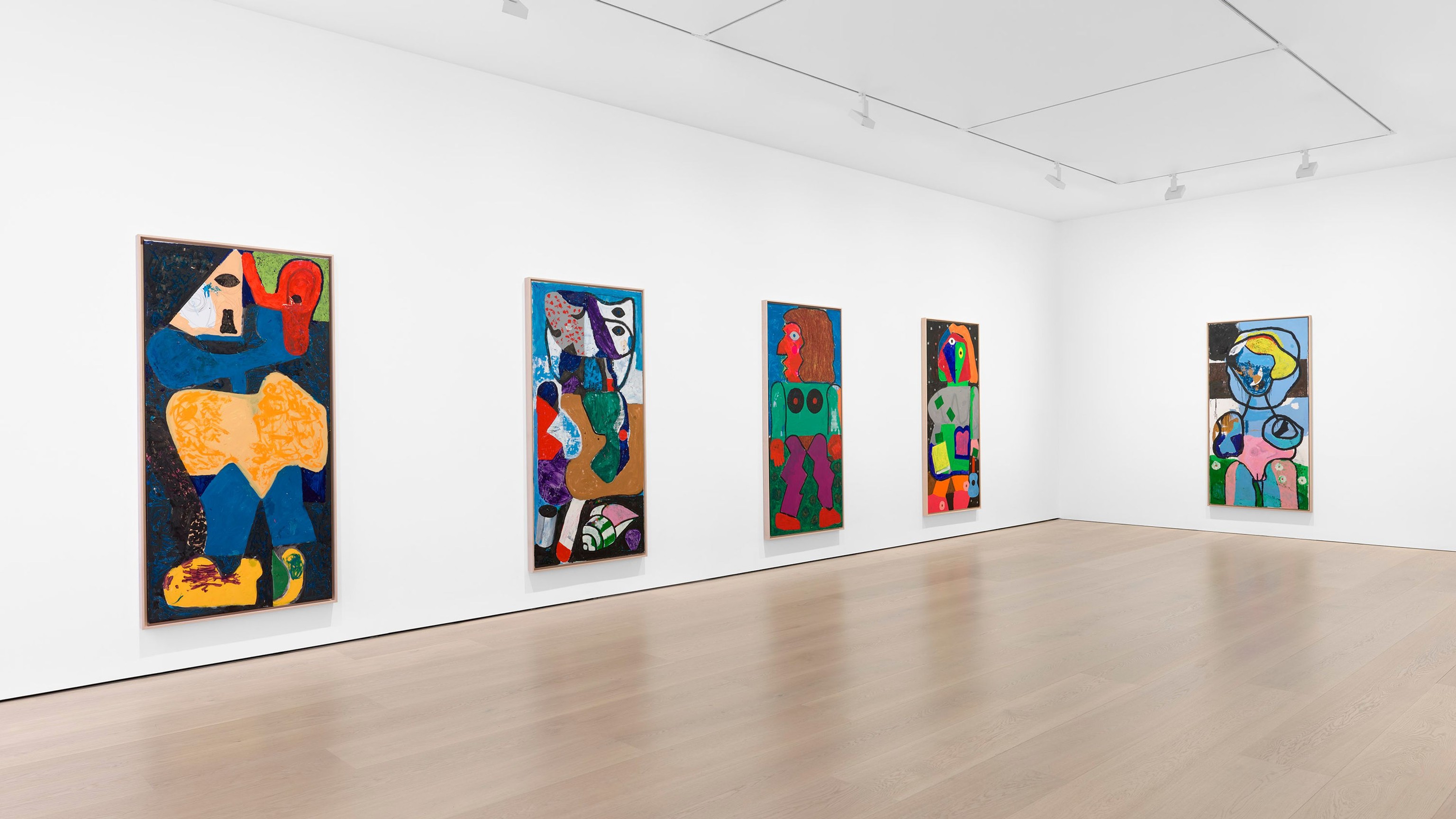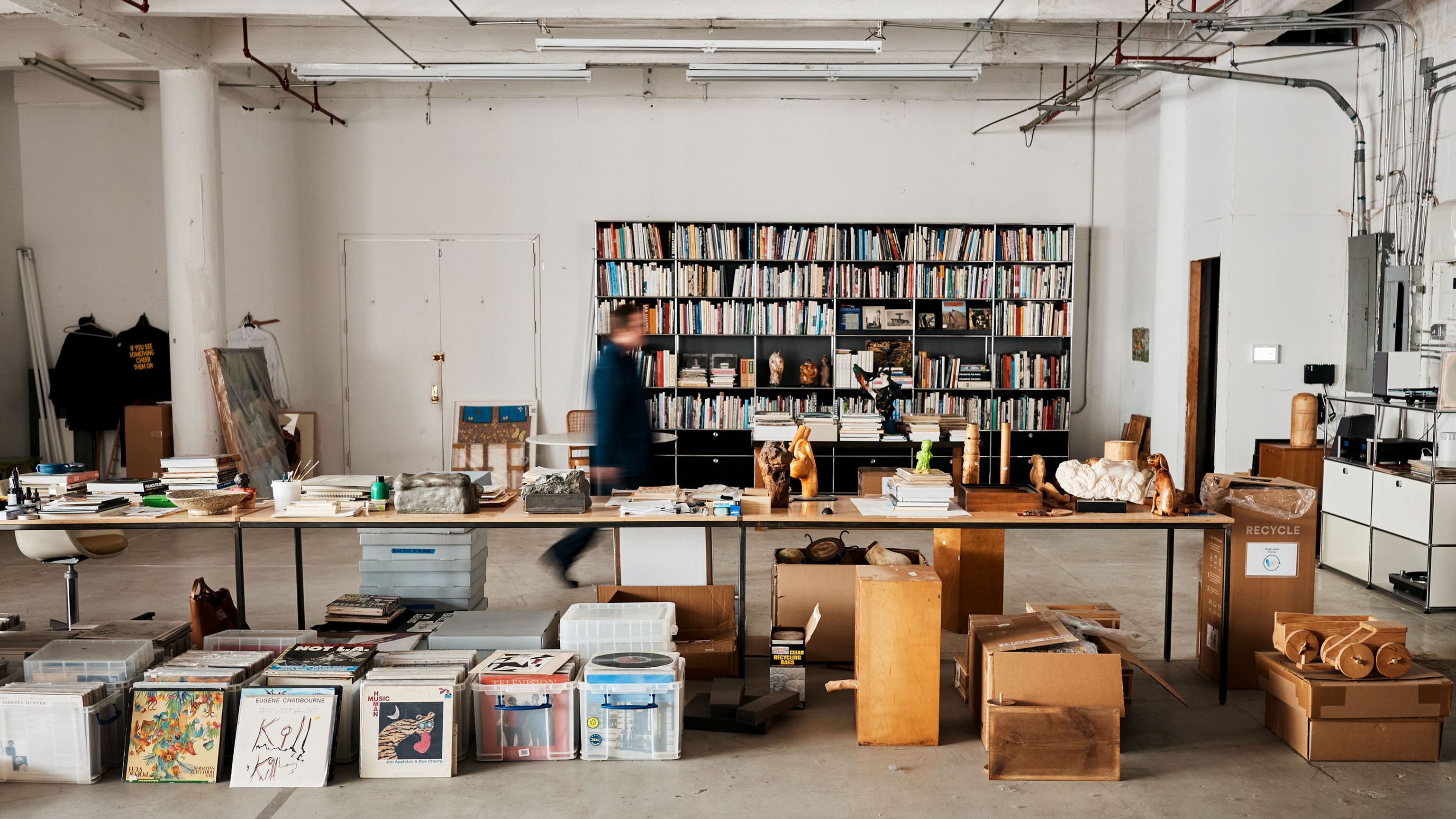Royal Academy of Arts Magazine, London
Article
2025
émergent, London
Interview
2025
— Extract —
Charlie Mills: It’s so great to be able to speak. I have been a fan of your work for some time, having first seen your solo show Day World with Gagosian in London in 2018. And so, I wanted to start this interview by asking you to introduce your forthcoming exhibition with David Zwirner opening on 6 June 2025. How long have you been working on this project and what works will be included in the show?
Joe Bradley: I’ve been working on the show for about a year, although some of the paintings have been kicking around the studio for the past few. The title of the show is ‘Animal Family’, it will include 13 new paintings and a group of drawings. There’s a push towards figuration in this new work that I find exciting, particularly in a suite of five tall vertical paintings. These ones are pretty explicitly based in the human form. The body has been present in my work in the past, but it has always been sublimated in a way that maybe I can see, but for the viewer it’s kind of buried. And then there’s a sort of animal-like form that pops up in a couple of paintings. You know, I thought… We’ve been painting bulls and horses and this sort of thing for a long time… so as a motif, it is tried and true.
For a long time, indeed. Have you visited Lascaux Cave in France? There is the famous ‘Hall of the Bulls’ there, but there are many examples of prehistoric cave painting that include bulls, equine and other animal forms, such as The Cave of Altamira in Spain. These sites and their artworks have in a way become an urtext for painting. They must be an influence for you?
I have a number of books on the subject, but I've never actually visited one of the caves.
And what about Animal Family, is there a particular reason for that title? Did it come from a particular place?
I went through a few titles while putting this show together. For a while it was ‘Late Work’, which I thought was funny, but too morbid. Then the working title was ‘Animal Shapes’, which I borrowed from David Berman, and that kind of morphed into ‘Animal Family’. I think it rolls off the tongue a bit better. The titles for my shows or paintings aren’t meant to illustrate a point, but to create a sort of ambiance for the work to live in. That said, there is something about this group of paintings, there’s a sense that they’re a family or a gang or something. They belong together.
Something which has defined your career is a consistent movement through different formal and material languages of painting. These bodies of work – whether your modular paintings of the mid-2000s or the following series of ‘Schmagoo’ paintings, through to more gestural abstraction through the 2010s – can often take a number of years to work through and refine for the purpose of an exhibition. For instance, your most recent show at David Zwirner New York in 2024, Vom Abend, you worked on around 30 paintings simultaneously for a number of years: coming to things, leaving things, having time to muse, having space for nonlinear thinking. I wonder whether it’s been a similar case for this show? Do you see the works in Animal Family as distinct from Vom Abend, or do you feel as though they have emerged in tandem or evolved out of it?
I think of the paintings in Animal Family as a pretty seamless continuation of those in Vom Abend. The way that I work, typically I’ll have a group of paintings in progress leading up to an exhibition, and there’s usually five or six that either don’t feel right for the show or just haven't been resolved in time. These make for a bread crumb trail to the next group and create a kind of natural progression. So even though the paintings in ‘Animal Family’ have qualities that might distinguish them from those in Vom Abend, I think you could hang them together and they would make sense.
And where did the pull come to lean into figuration? There’s still plenty of abstraction and experimentation happening here, and in the past you have been no stranger to figuration – although perhaps in a more oblique fashion – such as the modular paintings, or even the profiles and eyes one can intuit in Vom Abend. But to use the full human figure as a scribe for the composition of an abstract painting seems new?
Well, there was a painting in the last show titled Angel’s Trumpet (2024) in which the female form emerged, sort of a big pink Venus. She was hard to miss. The painting was a bit of an outlier, but I felt it jibed with the others and added something to show. Angel’s Trumpet pointed the way for this new group of paintings and granted permission, if you will, to move forward. Really, the whole thing is driven by intuition and desire. If I wanna try something out in the studio, it may not always work, but I need to give myself the freedom to follow my nose.
In an interview that you gave recently for your 2022 Xavier Hufkins show in Brussels, New Paltz, you mention having a desire to merge your drawing practice with that of your painting practice. These things are never fully separated in the way we think and feel about what we make, but in terms of the formal language, perhaps bringing those things closer together is happening for the new works in Animal Family. The use of a certain kind of line language as a composition tool.
For me, drawing is more or less a casual thing. The stakes are so low working with pencil and paper, and it’s so much easier than painting, that it lends itself to a kind of risk taking that is harder to pull off on canvas. I’ve always felt that my drawings are somehow out ahead of my paintings, that there are moves I make on paper that for whatever reason I don’t feel comfortable incorporating into the paintings. And I guess at a certain point it’s like: well, why not? What have I got to lose? So, yeah, there is a desire to join the two, and I think it’s visible in the work. Drawing is very much present in these paintings in a way that it wasn’t in my last London show.
You’ve mentioned channeling intuition and desire, a kind of liberated action or gesture. But on the other hand, I see a kind of problem-solving approach. Coming back to the canvas after fallow periods in the studio, ruminating and working over long periods of time. They are intuitive and spontaneous, but there’s also time, reflection and non-linear thinking built into the process. Using materiality to work with form or using form to help with the application and texture of paint.
When I’m working on a painting, the first half of the process is more or less free improvisation. Just fooling around with paint and seeing where it goes. This is kind of like planting seeds, but also setting little traps and creating obstacles to encounter further down the road. When the painting begins to take shape, it’s more about refining the thing and pushing to turn it into a cohesive picture, to give it a sense of structure and balance. It kind of engages both sides of the brain.
Having the luxury to work on these things over a long period of time, to be able to step away from a painting is essential to the way they come together. It has something to do with losing contact with the painting. If the signal goes cold, I can look at it again with fresh eyes and I might see some potential or simply know what to do with it next. So often, I’ll put a painting away, hide it from myself for a while. If I feel too attached to a painting, it becomes difficult to go back into it. Also, there is a certain texture and surface quality I’m shooting for that can only happen over time. It’s not something I can arrive at in a day or a week.




C-Mine, Genk
Exhibition Text
2025
Hannah Barry Gallery x Foolscap Editions, London
Editor
2025
Lo Brutto Stahl, Paris & Basel
Exhibition Text
2024
Hannah Barry Gallery x Foolscap Editions, London
Editor
2024
émergent, London
Interview
2024
DUVE, Berlin
Exhibition Text
2024
émergent, London
Interview
2024
Incubator, London
Exhibition Text
2023
QUEERCIRCLE, London
Exhibition Text
2023
L.U.P.O., Milan
Catalogue Essay
2023
Tarmac Press, Herne Bay
Catalogue Essay
2023
Brooke Bennington, London
Exhibition Text
2023
Freelands Foundation, London
Catalogue Essay
2023
superzoom, Paris
Exhibition Text
2023
Lichen Books, London
Catalogue Essay
2022
Tennis Elbow, New York
Exhibition Text
2022
émergent, London
Interview
2022
Guts Gallery, London
Exhibition Text
2021
Kupfer Projects, London
Exhibition Text
2021
Collective Ending, London
Catalogue Essay
2021
L21 Gallery S’Escorxador, Palma De Mallorca
Exhibition Text
2021
TJ Boulting, London
Exhibition Text
2021
COEVAL, Berlin
Interview
2021
Quench Gallery, Margate
Exhibition Text
2021
COEVAL, Berlin
Interview
2021
COEVAL, Berlin
Interview
2021
Foolscap Editions, London
Catalogue Essay
2020
Gentrified Underground, Zurich
Catalogue Essay
2020
Camberwell College of Arts, London
Exhibition Text
2019
Kronos Publishing, London
Editor
2019
Elam Publishing, London
Editor
2019
William Bennington Gallery, London
Catalogue Essay
2019
Elam Publishing, London
Catalogue Essay
2018
Camberwell College of Arts, London
Exhibition Text
2018
Limbo Limbo, London
Exhibition Text
2017
Saatchi Art & Music Magazine, London
Review
2017
B.A.E.S., London
Exhibition Text
2016